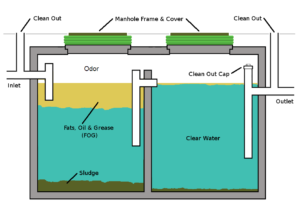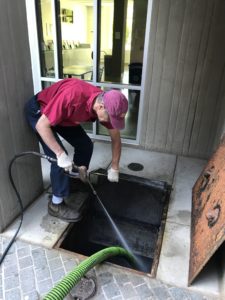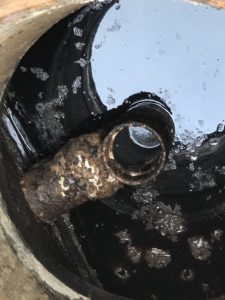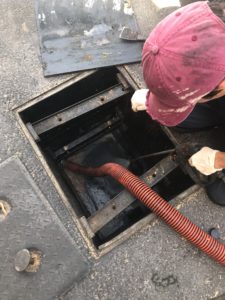What is a Grease Trap or Interceptor, and why are they necessary?
A trap or interceptor is designed to prevents grease and other undesirable waste from entering any municipal drain system. Communities are much more sensitive to preventing waste from entering the environment. Therefore, a properly installed and maintained collection system will keep you from having expensive emergency calls due to back-up’s, or worse, fines due to compliance standards not being met.
How does a grease trap work?
Depending on the nature of the food preparation and clean-up all that grease can fill up a trap very quickly. This image show’s how a grease trap works.

Why does it smell so bad?
The content of the trap comes from grease and food particles that are stored between cleaning intervals. The longer it stays in the trap the more it breaks down and decays creating odor. Odor is avoided when the lids/covers are properly fitted, installed and maintained. This is also one of the main reasons why we provide our service after hours to avoid any unpleasant odor for you and your patrons.

How frequently should it be cleaned?
This depends on the design of your grease and waste collection system and type of food prep. Smaller interior traps (10-50 gallons) with heavy food prep and grease utilization will require cleaning at least monthly or even every other week (bi-weekly). Larger exterior traps (100-5000 gallons) allow for greater time intervals between cleaning, quarterly or even semi-annually. However, the amount of grease and food that a kitchen releases into the trap is factored into the cleaning schedule. We work with our clients so that the cleaning schedule matches the systems ability to process the waste along with any municipal standards that need to be considered.
What can be done to make a grease trap work better, thus reducing cleaning and maintenance costs?
By not pouring grease or forcing food directly into the plumbing system during clean-up, that will reduce the amount entering the grease trap. Strainers will prevent food from going into the drains. Also even though it seems logical to pour industrial drain cleaning solutions into the drains, remember they are heavier than water and will collect directly in your trap…thus leading to a hole being eaten in the bottom of the trap and an expensive fix.
All you do is vacuum out the trap, right?
No. We pump out the contents of the trap, power-wash the side, clean the inlet and outlet, scrape any solids that have built up on the sides, and inspect everything to make sure it will continue to operate properly.

Grease Trap Inlet Before Service:

Inlet After Service:

We clean everything!

